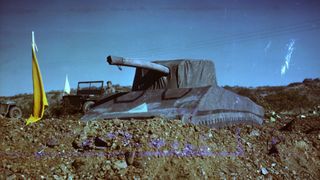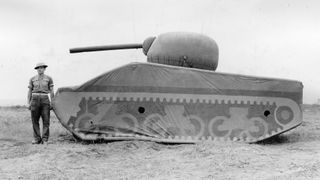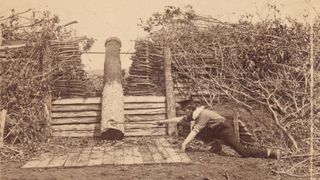'Ghost Army' in WWII used inflatable tanks to fool the Nazis and win the war
This special U.S. Army unit remained secret for over 40 years.

Today (Sept. 2) marks the 75th anniversary of Word War II's end. During this historic global conflict, hundreds of bloody skirmishes were waged on land, sea and air. But one top-secret U.S. Army battalion fought not with bullets but with stagecraft, using inflatable life-size tanks, phony insignias, soundscapes and fake radio transmissions to deceive German soldiers on the battlefield.
The 23rd Headquarters Special Troops, also known as the "Ghost Army," brought together artists, career military officers and audio experts in a unique unit devoted to the art of deception — "the first mobile, multimedia, tactical deception unit in U.S. Army history," according to the National WWII Museum in New Orleans. The museum features a number of Ghost Army artifacts in the special exhibit "Ghost Army: The Combat Con Artists of World War II," on display until Jan. 3, 2021.
Using a combination of science and art, the Ghost Army staged nearly two dozen missions between May 1944 and 1945 with the sole purpose of tricking Nazi troops about the whereabouts of Allied forces in Europe. In the process, their efforts saved the lives of thousands of Allied soldiers. Its existence was kept secret for more than 40 years after the war's end; the Ghost Army remained officially classified until the mid-1990s, according to the WWII Museum.
Related: The 22 weirdest military weapons
"In the past, when deception operations took place, it was usually a temporary duty," said Larry Decuers, a curator at the WWII Museum. "This was a ground-up unit designed specifically for deception."
London-based U.S. Army officers Col. Billy Harris and Maj. Ralph Ingersoll guided the formation of the Ghost Army, inspired by the success of British deception tactics in North Africa, Decuers told Live Science. The British Army's Operation Bertram, staged in 1942, used camouflage and more than 2,000 dummy vehicles to convince the Germans that the British were strengthening a position in the south, and to conceal British mobilization in the north, according to the website History of War.

Leading the Ghost Army was Col. Harry L. Reeder, supervising 82 army officers and 1,023 recruits; among them were art students from the Industrial Camouflage Program at the Pratt Institute in New York, fashion designer Bill Blass, photographer Art Kane and painter Ellsworth Kelly.
Sign up for the Live Science daily newsletter now
Get the world’s most fascinating discoveries delivered straight to your inbox.
These and other strategists designed a four-part approach to bring phantom army battalions to life, Decuers explained.
"The first element was the camouflage engineer battalion — the guys who dealt with the inflatable vehicles, inflatable tanks," he said. These tanks could easily be lifted and moved into position by just a few men, but from a distance they were nearly impossible to distinguish from the real thing. The second element was a signal company that concocted fake radio traffic; the radio operators were so skilled that they could mimic the morse code "fist" — the sending style — of operators in specific army units, to make fake dispatches sound authentic.
"To the trained ear, that telegraphic fist is almost like a fingerprint," Decuers said.

Related: The flying bombs of Nazi Germany
A third element of the Ghost Army was sonic deception. Audio engineers pre-recorded sounds of military training exercises and the construction of trenches and bridges, and then edited them into soundscapes that could be played on massive speakers within range of German troops, to convince the Nazis that entire combat units occupied locations that were undefended.
And then a fourth layer of deception was supplied by the unit's combat engineer company, which would don the insignias of other military units to confuse the Germans or to mislead potential spies in nearby towns.
"Their most successful operation was Operation Viersen," which took place from March 18 to March 24, 1945, Decuers said. For that mission, the Ghost Army used 600 inflatable vehicles; fake uniform patches to impersonate soldiers from other units; and recordings of pontoon bridge-building, "all to deceive the Germans into believing that the 30th Infantry Division and the 79th Infantry Division were preparing to cross the Rhine River," Decuers said. And it worked. The Germans moved the bulk of their defenses across the river from the suspected location of the two divisions, shelling an army that didn't exist.
And when the Nazis were busy chasing shadows, they weren't engaging the real Allied combat divisions.
"It was like a traveling road show that went up and down the front lines impersonating the real fighting outfits," according to the Ghost Army Legacy Project.
"Attack when they are unprepared"
Though the Ghost Army's audio technologies weren't available to their predecessors, the art of military deception is likely as old as war itself, and canny leaders have schemed their way to victory for thousands of years. In one of the most famous examples, documented in the eighth century B.C. by the poet Homer, the Greek army wins the Trojan War after they tricked the city of Troy into accepting a gift of a giant wooden horse — with Greek soldiers hiding inside.
Sun Tzu, a renowned general and philosopher who lived in China during the sixth century B.C., wrote "all warfare is based upon deception" in "The Art of War," a book that defined military strategy for centuries, and is studied to this day. It outlined a dozen methods of military deception, including: "When one is capable, give the appearance of being incapable;" "when one is near, give the appearance of being far;" and "attack them when they are unprepared, come forth when they are not expecting you to do so," according to the U.S. Naval Institute.

Confederate generals during the American Civil War also used deception to save the day when they were outnumbered and outgunned. They carved and painted logs to resemble cannons, arranging them around encampments so that Union spies wouldn't suspect that their foes were short on weapons and supplies, according to the Federation of American Scientists.
But the Ghost Army was one of the first known specialized military units that was created specifically to confuse and trick the enemy, Decuers told Live Science.
"Deception has played a major part throughout the history of warfare," he said. "What was new, was this unit was put together to deceive in every way possible. It was their sole mission."
Originally published on Live Science.

Mindy Weisberger is an editor at Scholastic and a former Live Science channel editor and senior writer. She has reported on general science, covering climate change, paleontology, biology, and space. Mindy studied film at Columbia University; prior to Live Science she produced, wrote and directed media for the American Museum of Natural History in New York City. Her videos about dinosaurs, astrophysics, biodiversity and evolution appear in museums and science centers worldwide, earning awards such as the CINE Golden Eagle and the Communicator Award of Excellence. Her writing has also appeared in Scientific American, The Washington Post and How It Works Magazine.
-
Secundius Even the Germans produced "Quaker Fortifications" in WW2 to confuse the Allies as to just how fortified the Normandy Beach actual was. "Batterie allemande" near Bayneux was attacked and bombed by the Allies only to find there was nothing there worth all the lives and munitions cost used to find outReply
